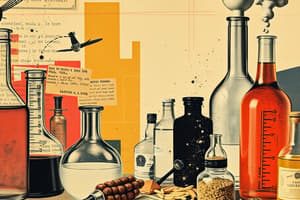Podcast
Questions and Answers
Which of the following accurately describes a chemical property of matter?
Which of the following accurately describes a chemical property of matter?
- Color
- Size
- Shape
- Flammability (correct)
Which of the following statements is true about pure substances?
Which of the following statements is true about pure substances?
- They can vary in composition.
- They are made up of various atom combinations.
- They have a definite or fixed composition. (correct)
- They cannot undergo chemical reactions.
What characteristic do metals generally possess?
What characteristic do metals generally possess?
- Poor conductors of heat
- Dull appearance and gas form
- Solid at room temperature and ductility (correct)
- Liquid state at high temperatures only
Which element is categorized as a nonmetal and exists in liquid form at room temperature?
Which element is categorized as a nonmetal and exists in liquid form at room temperature?
Which statement about mixtures is accurate?
Which statement about mixtures is accurate?
Which of the following best describes metalloids?
Which of the following best describes metalloids?
What characterizes compounds that are classified as ionic?
What characterizes compounds that are classified as ionic?
How many naturally occurring elements are there in the periodic table?
How many naturally occurring elements are there in the periodic table?
What is the main distinction between organic and inorganic compounds?
What is the main distinction between organic and inorganic compounds?
Which type of chemical reaction absorbs heat during the process?
Which type of chemical reaction absorbs heat during the process?
What describes how elements are organized in the periodic table?
What describes how elements are organized in the periodic table?
Which of the following is a characteristic of a pure substance?
Which of the following is a characteristic of a pure substance?
Which of the following statements is true regarding the periodic table?
Which of the following statements is true regarding the periodic table?
Flashcards are hidden until you start studying
Study Notes
Properties of Matter
- Matter can be classified based on physical and chemical properties.
- Physical properties: Observable characteristics without altering the substance's composition; includes color, size, shape.
- Chemical properties: Observed when a material undergoes a chemical reaction; includes flammability, reactivity, biodegradability.
Classification of Matter
- Pure Substance: Matter with a fixed composition, consists of a specific number of atoms combined through chemical reactions.
- Mixtures: Combinations of two or more substances that possess distinct physical and chemical properties.
Metals and Nonmetals
- Metals: Usually solid at room temperature, lustrous, malleable, ductile, good conductors of heat and electricity.
- Nonmetals: Generally gaseous or dull solids, poor conductors of heat and electricity.
Elements and Compounds
- Elements: Cannot be broken down into simpler forms.
- 118 elements categorized in the periodic table: 94 naturally occurring, 24 synthetic.
- Compounds: Composed of two or more different elements in fixed ratios, formed via chemical bonding.
- Can be ionic or covalent based on the type of bonding.
Periodic Table of Elements
- Organizes elements in rows (periods) and columns (groups) based on similar properties.
- Each entry includes the element's symbol, name, atomic number, and atomic mass.
- Classifies elements into three categories: metals (left), nonmetals (right), metalloids (between metals and nonmetals).
Organic and Inorganic Compounds
- Organic Compounds: Contain carbon and hydrogen; examples include carbohydrates, proteins, lipids.
- Inorganic Compounds: Do not contain carbon-hydrogen bonds; examples include CO2, H2O, table salt (NaCl).
Chemical Reactions
- Process of creating new compounds through chemical changes.
- Exothermic Reactions: Release heat during the reaction, e.g., combustion.
- Endothermic Reactions: Absorb heat, allowing for the formation of new compounds, e.g., photosynthesis.
Ionic Compounds
- Formed through ionic bonding, involving the transfer of electrons.
- Composed of cations (positively charged) and anions (negatively charged).
Studying That Suits You
Use AI to generate personalized quizzes and flashcards to suit your learning preferences.




